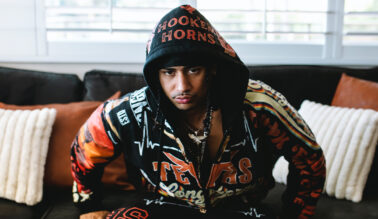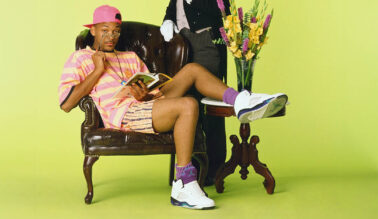This post may contain affiliate links. Please read our disclosure policy.
Nice Kicks: What was it like working with LeBron and his team?
Paul Rivera: It was great. As you can imagine, working on any athlete’s business is a huge ordeal with a huge team behind it. Amplify that by a million when you’re working with an athlete like LeBron James. It was cool in that I got to work across all facets of his business. My job was to brief every team under the LeBron line on what the story was going to be for the year. I do that, they all go into their corner with their team to manifest how that works for their category function, and they come back with a pitch. My job was to make sure that we, as Nike Basketball, told a cohesive story, and all of that starts with insights from the athlete. “LeBron, is this true to you?” “Is this authentic to you?” It all starts from the athlete insight.
Nice Kicks: How does the value of authenticity play into the concept of storytelling?
Paul Rivera: One of the main things about Nike is that they never do anything just to do it. There’s a story behind everything and it really does start with that insight. You will never see anything in the LeBron line that isn’t authentic to LeBron. Everything that goes out the door goes off LeBron’s desk. He is invested in it. He cares about his brand and his team does too. When we talk about storytelling, we’re talking about being authentic to LeBron himself and every athlete at Nike. We take a lot of the ambiguity out of it. You may like it, you may not, but it’s authentic to the athlete. While you and I may look at it as storytelling, Nike and LeBron look at it as what they’re going to stand for. That may be when he’s on the court his inspiration for the game or, off the court, his love for music. Regardless, the stories may change, but the authenticity never does.
Nice Kicks: What was the the first shoe you worked on within the LeBron line?
Paul Rivera: I came in during the end of the LeBron 8, worked on all of the LeBron 9, and then left prior to the LeBron X launch. I didn’t work too much on the 8, but I can tell you that everyone felt really good about the 8 from LeBron on down. In the past, some people, whether right or wrong, have been like, “Hey, this is a performance shoe or this is a cultural shoe.” The 8 was just a dope shoe. You saw it on the court just as much as you saw it off the court. What I remember about the 8 is that everyone was really excited about it, including LeBron himself. That’s always my gauge: When LeBron is asking, “Can I wear the shoe now?” and you’re like, “No, you can’t, you’ve got to wait.” When an athlete that has access to everything is super excited about the shoe you know you’ve nailed it.
Nice Kicks: Nike Basketball designer Jason Petrie (pictured below) was behind those three models. What was it like working with Jason and the creative team behind the LeBron line?
Paul Rivera: Jason Petrie, I call him the mad scientist. I think he’s brilliant. Jay came with us on the tour. A lot of the [creative process] isn’t as formal as you think it is. Yes, you have the Q&As, but a lot of [the inspiration] is spontaneous and I always think that’s the best stuff. When you’re eating lunch and a comment is made or you meet LeBron after the game and he’s showing you his new car that he’s excited about. A designer can take inspiration from the rims or from the piping on the leather seats. That’s what Nike does and that’s what the designers do that set them apart, in my humble opinion, from everyone else. I remember with the 8 everyone was just super excited about it. We never questioned if the 8 was going to be a successful shoe, [but rather] how successful. In my humble opinion, the 8 kind of turned it around and became the shoe.
Nice Kicks: Any specific examples of spontaneous moments that led to actual LeBrons?
Paul Rivera: That’s more on the designer side. I can tell you that if you sat with the whole team, I’m sure there is an example for each one of the colorways. For me, I remember when LeBron got a black-on-black Mini Cooper and it really looked like a miniature version of an armored truck. I’m talking with LeBron after a playoff game and we’re just talking about the game and how he’s feeling. I turn around and look and Jay is there with a book writing notes. And I’m like, “Yo Mad Scientist, what are you doing?” Everyone starts laughing and Jay’s like, “Oh, I’m just taking some notes, finding some inspiration.” A designer’s aperture is bigger. They find that inspiration everywhere and turn it into product stories.
Nice Kicks: What were the biggest challenges when working on the LeBron line?
Paul Rivera: I wouldn’t say we necessarily had any challenges to be honest. Obviously there are challenges in everything. For me, you can look at other athletes, other sports, other brands, and there are off-seasons. There’s time when the light is bright and you’ve got to get stuff done, there are definitely peak moments. Then, there are moments when you’re not in the spotlight and you can take some time, go off-site and brainstorm. There is no off time for LeBron and for his brand. At all. When you look at the last 24 months he had, he won the regular season MVP, a championship, Finals MVP, an Olympic gold medal, and then he came back and won another regular season MVP, championship, and Finals MVP. I don’t know if there’s ever really been another run like that before in any sport. For me, the challenge was you could never celebrate a win – it was always on to the next one. The pace of it was just unrivaled and it should be. For me, I was always [thinking] we can’t let LeBron outwork us. For all he’s doing on the court we’ve got to do that for him off the court. With LeBron, you have to plan for the unexpected. Every year, you have to plan and assume he’s going to the All-Star Game, that he’s making the playoffs, that he’s winning MVP, that he’s winning a championship. It doesn’t stop. When you’re looking at it from a product standpoint or a planning or marketing standpoint, there really is no off-season ever. But I would argue that’s how it should be. He doesn’t have an off-season, he’s constantly working on his game.
Nice Kicks: When is it time to celebrate all those accomplishments with retro product?
Paul Rivera: [Laughs] That’s the billion dollar question, my friend. As you know, when he won his first championship that question came up a hundred million times and I don’t think anyone has the answer. Knowing Nike and knowing LeBron as good as I do, they’ll do it exactly when the moment calls for it. I can’t tell you when that is because I don’t know to be completely honest with you. I will say that it wasn’t even a conversation before and now it is.
Nice Kicks: What was your biggest takeaway from working at Nike Basketball?
Paul Rivera: Honestly, it may sound corny but my biggest takeaway was the passion. Everyone from Jason Petrie to the interns, no one really views Nike Basketball as a job. You just live it. You always talk about work/life balances in places. The way that people do it at Nike is to figure out a way to seamlessly integrate your life into work. I don’t mean the work came first over family, I just mean that everyone was passionate and lived it. When you do that, there is no down time because everyone loves their job. When you’re working with a team full of perfectionists, you can’t help but come out with amazing products, amazing marketing, and amazing storytelling. That’s not to say that everything is perfect or everyone is going to love everything, but you can feel good about it when you know it’s authentic to the athlete. The passion that everyone had on that team, I’ve never seen anything like that. When you hear that, it’s no surprise that they are who they are and Nike is what it is. It’s not just, ‘oh that’s a dope colorway’ and everyone likes it. It’s a lot of time, a lot of effort and a lot of hours [invested into the product]. For every [product] you see, there’s probably nine things that have been killed. Just that passion, I’ve never seen anything like it. The passion that you see from LeBron on court is matched by the passion by the team behind closed doors.



